BTEC Level 3 Health & Social Care: Unit 38 Environmental Health Report
VerifiedAdded on 2023/06/05
|7
|1941
|358
Report
AI Summary
This report, prepared for a BTEC Level 3 Extended Diploma in Health & Social Care, focuses on the impact of human activities on the environment, specifically addressing Unit 38: Environmental Health. The report examines various aspects of human influence, including the effects of technology, agriculture, irrigation, the energy industry, and transport. It highlights the role of these activities in causing pollution, increasing greenhouse emissions, and depleting natural resources, ultimately leading to climate change and environmental degradation. The report also discusses specific examples like the impact of agriculture on soil, air, and water, and the effects of the energy industry's reliance on fossil fuels. It concludes by emphasizing the need for sustainable practices and solutions to mitigate environmental damage, such as eco-friendly transportation and less harmful agricultural practices. References from various academic sources support the analysis.
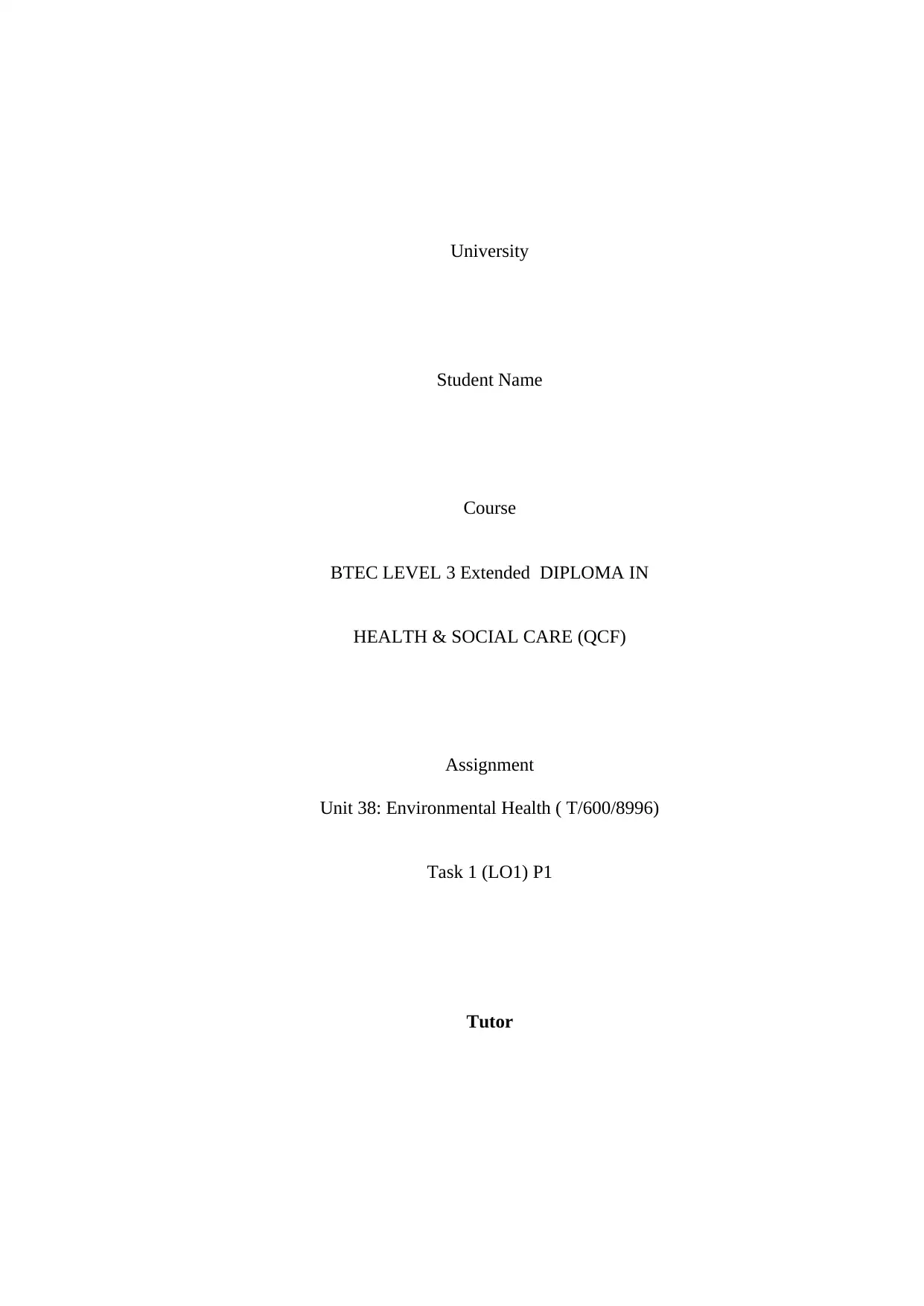
University
Student Name
Course
BTEC LEVEL 3 Extended DIPLOMA IN
HEALTH & SOCIAL CARE (QCF)
Assignment
Unit 38: Environmental Health ( T/600/8996)
Task 1 (LO1) P1
Tutor
Student Name
Course
BTEC LEVEL 3 Extended DIPLOMA IN
HEALTH & SOCIAL CARE (QCF)
Assignment
Unit 38: Environmental Health ( T/600/8996)
Task 1 (LO1) P1
Tutor
Paraphrase This Document
Need a fresh take? Get an instant paraphrase of this document with our AI Paraphraser
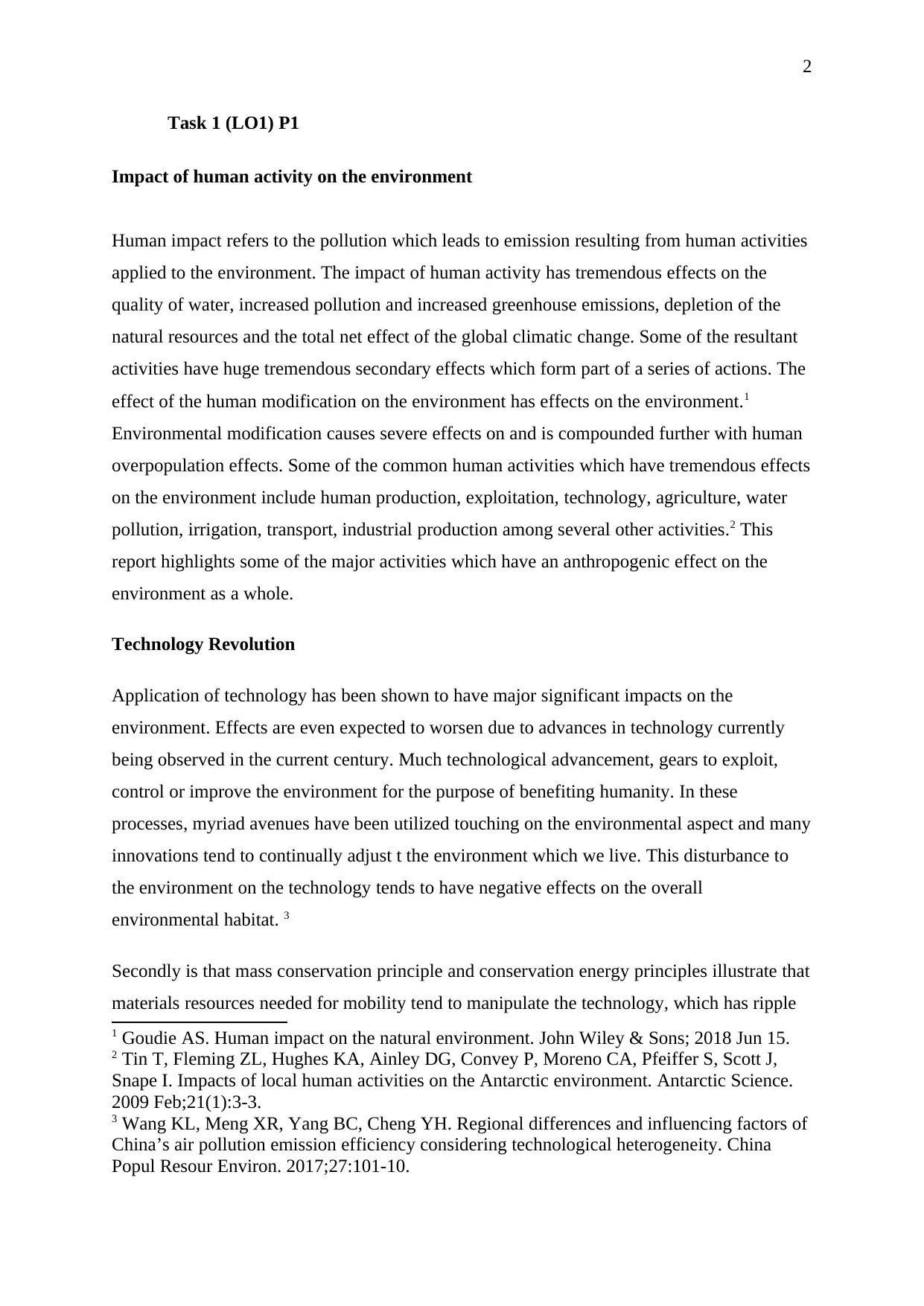
2
Task 1 (LO1) P1
Impact of human activity on the environment
Human impact refers to the pollution which leads to emission resulting from human activities
applied to the environment. The impact of human activity has tremendous effects on the
quality of water, increased pollution and increased greenhouse emissions, depletion of the
natural resources and the total net effect of the global climatic change. Some of the resultant
activities have huge tremendous secondary effects which form part of a series of actions. The
effect of the human modification on the environment has effects on the environment.1
Environmental modification causes severe effects on and is compounded further with human
overpopulation effects. Some of the common human activities which have tremendous effects
on the environment include human production, exploitation, technology, agriculture, water
pollution, irrigation, transport, industrial production among several other activities.2 This
report highlights some of the major activities which have an anthropogenic effect on the
environment as a whole.
Technology Revolution
Application of technology has been shown to have major significant impacts on the
environment. Effects are even expected to worsen due to advances in technology currently
being observed in the current century. Much technological advancement, gears to exploit,
control or improve the environment for the purpose of benefiting humanity. In these
processes, myriad avenues have been utilized touching on the environmental aspect and many
innovations tend to continually adjust t the environment which we live. This disturbance to
the environment on the technology tends to have negative effects on the overall
environmental habitat. 3
Secondly is that mass conservation principle and conservation energy principles illustrate that
materials resources needed for mobility tend to manipulate the technology, which has ripple
1 Goudie AS. Human impact on the natural environment. John Wiley & Sons; 2018 Jun 15.
2 Tin T, Fleming ZL, Hughes KA, Ainley DG, Convey P, Moreno CA, Pfeiffer S, Scott J,
Snape I. Impacts of local human activities on the Antarctic environment. Antarctic Science.
2009 Feb;21(1):3-3.
3 Wang KL, Meng XR, Yang BC, Cheng YH. Regional differences and influencing factors of
China’s air pollution emission efficiency considering technological heterogeneity. China
Popul Resour Environ. 2017;27:101-10.
Task 1 (LO1) P1
Impact of human activity on the environment
Human impact refers to the pollution which leads to emission resulting from human activities
applied to the environment. The impact of human activity has tremendous effects on the
quality of water, increased pollution and increased greenhouse emissions, depletion of the
natural resources and the total net effect of the global climatic change. Some of the resultant
activities have huge tremendous secondary effects which form part of a series of actions. The
effect of the human modification on the environment has effects on the environment.1
Environmental modification causes severe effects on and is compounded further with human
overpopulation effects. Some of the common human activities which have tremendous effects
on the environment include human production, exploitation, technology, agriculture, water
pollution, irrigation, transport, industrial production among several other activities.2 This
report highlights some of the major activities which have an anthropogenic effect on the
environment as a whole.
Technology Revolution
Application of technology has been shown to have major significant impacts on the
environment. Effects are even expected to worsen due to advances in technology currently
being observed in the current century. Much technological advancement, gears to exploit,
control or improve the environment for the purpose of benefiting humanity. In these
processes, myriad avenues have been utilized touching on the environmental aspect and many
innovations tend to continually adjust t the environment which we live. This disturbance to
the environment on the technology tends to have negative effects on the overall
environmental habitat. 3
Secondly is that mass conservation principle and conservation energy principles illustrate that
materials resources needed for mobility tend to manipulate the technology, which has ripple
1 Goudie AS. Human impact on the natural environment. John Wiley & Sons; 2018 Jun 15.
2 Tin T, Fleming ZL, Hughes KA, Ainley DG, Convey P, Moreno CA, Pfeiffer S, Scott J,
Snape I. Impacts of local human activities on the Antarctic environment. Antarctic Science.
2009 Feb;21(1):3-3.
3 Wang KL, Meng XR, Yang BC, Cheng YH. Regional differences and influencing factors of
China’s air pollution emission efficiency considering technological heterogeneity. China
Popul Resour Environ. 2017;27:101-10.
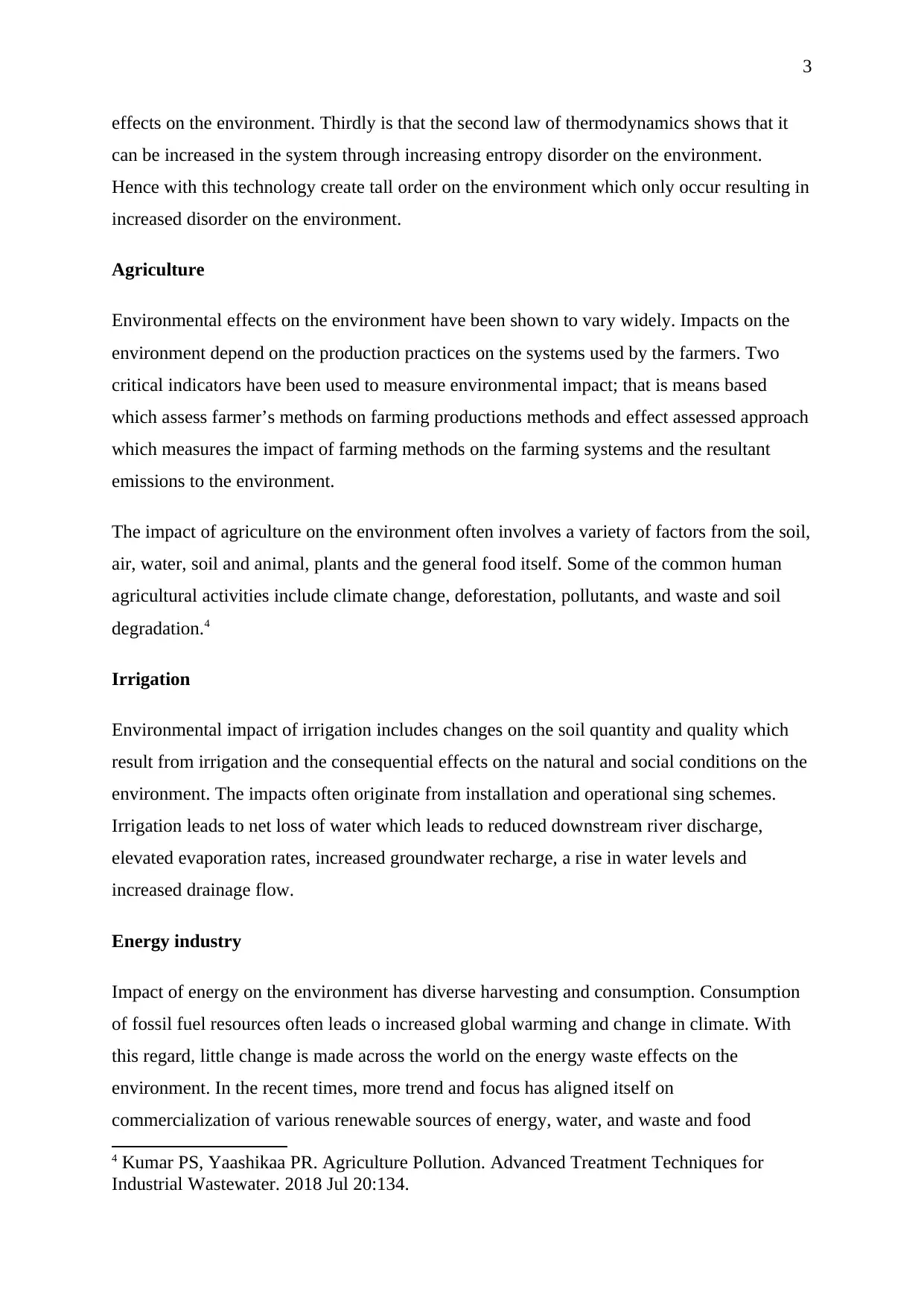
3
effects on the environment. Thirdly is that the second law of thermodynamics shows that it
can be increased in the system through increasing entropy disorder on the environment.
Hence with this technology create tall order on the environment which only occur resulting in
increased disorder on the environment.
Agriculture
Environmental effects on the environment have been shown to vary widely. Impacts on the
environment depend on the production practices on the systems used by the farmers. Two
critical indicators have been used to measure environmental impact; that is means based
which assess farmer’s methods on farming productions methods and effect assessed approach
which measures the impact of farming methods on the farming systems and the resultant
emissions to the environment.
The impact of agriculture on the environment often involves a variety of factors from the soil,
air, water, soil and animal, plants and the general food itself. Some of the common human
agricultural activities include climate change, deforestation, pollutants, and waste and soil
degradation.4
Irrigation
Environmental impact of irrigation includes changes on the soil quantity and quality which
result from irrigation and the consequential effects on the natural and social conditions on the
environment. The impacts often originate from installation and operational sing schemes.
Irrigation leads to net loss of water which leads to reduced downstream river discharge,
elevated evaporation rates, increased groundwater recharge, a rise in water levels and
increased drainage flow.
Energy industry
Impact of energy on the environment has diverse harvesting and consumption. Consumption
of fossil fuel resources often leads o increased global warming and change in climate. With
this regard, little change is made across the world on the energy waste effects on the
environment. In the recent times, more trend and focus has aligned itself on
commercialization of various renewable sources of energy, water, and waste and food
4 Kumar PS, Yaashikaa PR. Agriculture Pollution. Advanced Treatment Techniques for
Industrial Wastewater. 2018 Jul 20:134.
effects on the environment. Thirdly is that the second law of thermodynamics shows that it
can be increased in the system through increasing entropy disorder on the environment.
Hence with this technology create tall order on the environment which only occur resulting in
increased disorder on the environment.
Agriculture
Environmental effects on the environment have been shown to vary widely. Impacts on the
environment depend on the production practices on the systems used by the farmers. Two
critical indicators have been used to measure environmental impact; that is means based
which assess farmer’s methods on farming productions methods and effect assessed approach
which measures the impact of farming methods on the farming systems and the resultant
emissions to the environment.
The impact of agriculture on the environment often involves a variety of factors from the soil,
air, water, soil and animal, plants and the general food itself. Some of the common human
agricultural activities include climate change, deforestation, pollutants, and waste and soil
degradation.4
Irrigation
Environmental impact of irrigation includes changes on the soil quantity and quality which
result from irrigation and the consequential effects on the natural and social conditions on the
environment. The impacts often originate from installation and operational sing schemes.
Irrigation leads to net loss of water which leads to reduced downstream river discharge,
elevated evaporation rates, increased groundwater recharge, a rise in water levels and
increased drainage flow.
Energy industry
Impact of energy on the environment has diverse harvesting and consumption. Consumption
of fossil fuel resources often leads o increased global warming and change in climate. With
this regard, little change is made across the world on the energy waste effects on the
environment. In the recent times, more trend and focus has aligned itself on
commercialization of various renewable sources of energy, water, and waste and food
4 Kumar PS, Yaashikaa PR. Agriculture Pollution. Advanced Treatment Techniques for
Industrial Wastewater. 2018 Jul 20:134.
⊘ This is a preview!⊘
Do you want full access?
Subscribe today to unlock all pages.

Trusted by 1+ million students worldwide
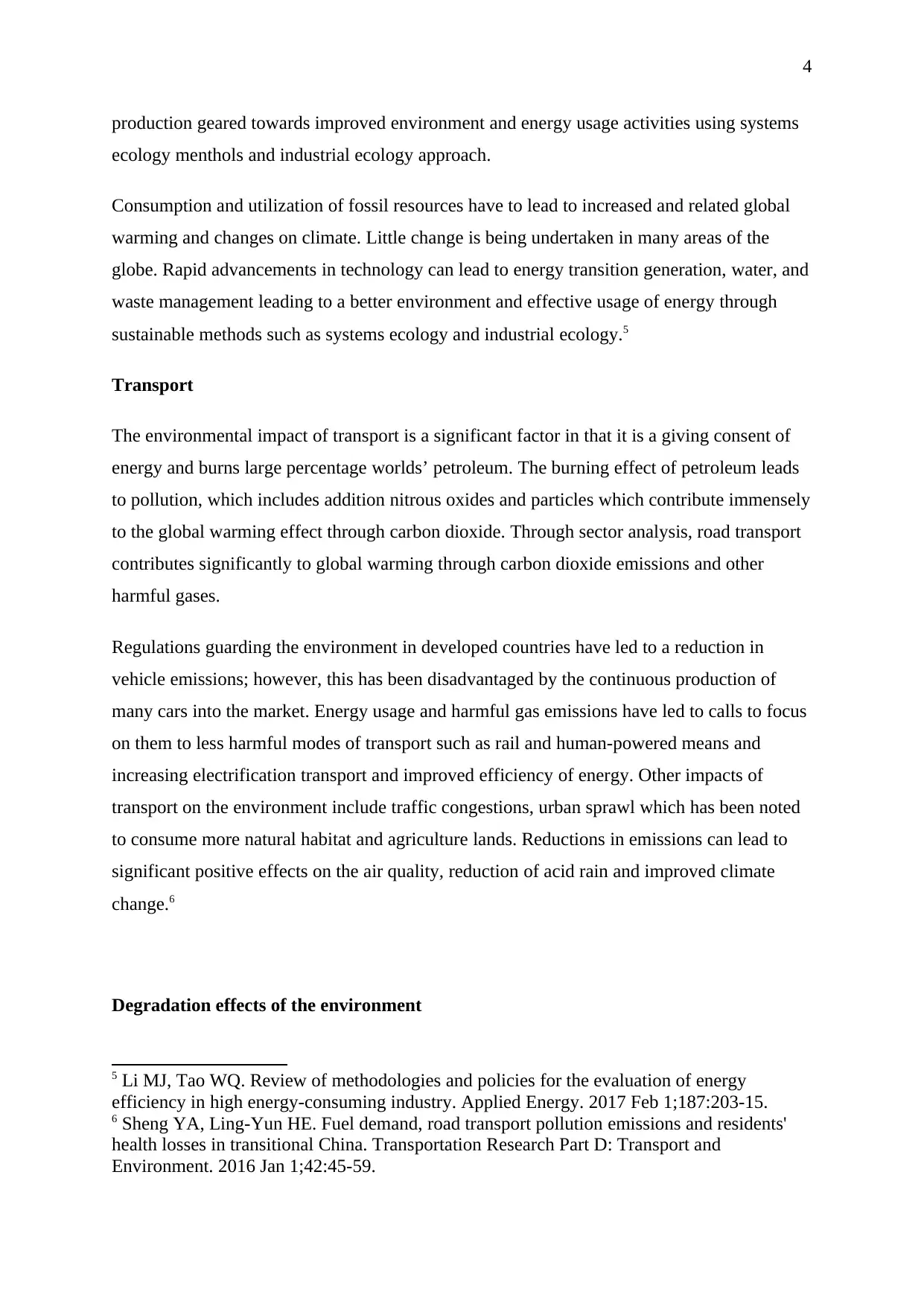
4
production geared towards improved environment and energy usage activities using systems
ecology menthols and industrial ecology approach.
Consumption and utilization of fossil resources have to lead to increased and related global
warming and changes on climate. Little change is being undertaken in many areas of the
globe. Rapid advancements in technology can lead to energy transition generation, water, and
waste management leading to a better environment and effective usage of energy through
sustainable methods such as systems ecology and industrial ecology.5
Transport
The environmental impact of transport is a significant factor in that it is a giving consent of
energy and burns large percentage worlds’ petroleum. The burning effect of petroleum leads
to pollution, which includes addition nitrous oxides and particles which contribute immensely
to the global warming effect through carbon dioxide. Through sector analysis, road transport
contributes significantly to global warming through carbon dioxide emissions and other
harmful gases.
Regulations guarding the environment in developed countries have led to a reduction in
vehicle emissions; however, this has been disadvantaged by the continuous production of
many cars into the market. Energy usage and harmful gas emissions have led to calls to focus
on them to less harmful modes of transport such as rail and human-powered means and
increasing electrification transport and improved efficiency of energy. Other impacts of
transport on the environment include traffic congestions, urban sprawl which has been noted
to consume more natural habitat and agriculture lands. Reductions in emissions can lead to
significant positive effects on the air quality, reduction of acid rain and improved climate
change.6
Degradation effects of the environment
5 Li MJ, Tao WQ. Review of methodologies and policies for the evaluation of energy
efficiency in high energy-consuming industry. Applied Energy. 2017 Feb 1;187:203-15.
6 Sheng YA, Ling-Yun HE. Fuel demand, road transport pollution emissions and residents'
health losses in transitional China. Transportation Research Part D: Transport and
Environment. 2016 Jan 1;42:45-59.
production geared towards improved environment and energy usage activities using systems
ecology menthols and industrial ecology approach.
Consumption and utilization of fossil resources have to lead to increased and related global
warming and changes on climate. Little change is being undertaken in many areas of the
globe. Rapid advancements in technology can lead to energy transition generation, water, and
waste management leading to a better environment and effective usage of energy through
sustainable methods such as systems ecology and industrial ecology.5
Transport
The environmental impact of transport is a significant factor in that it is a giving consent of
energy and burns large percentage worlds’ petroleum. The burning effect of petroleum leads
to pollution, which includes addition nitrous oxides and particles which contribute immensely
to the global warming effect through carbon dioxide. Through sector analysis, road transport
contributes significantly to global warming through carbon dioxide emissions and other
harmful gases.
Regulations guarding the environment in developed countries have led to a reduction in
vehicle emissions; however, this has been disadvantaged by the continuous production of
many cars into the market. Energy usage and harmful gas emissions have led to calls to focus
on them to less harmful modes of transport such as rail and human-powered means and
increasing electrification transport and improved efficiency of energy. Other impacts of
transport on the environment include traffic congestions, urban sprawl which has been noted
to consume more natural habitat and agriculture lands. Reductions in emissions can lead to
significant positive effects on the air quality, reduction of acid rain and improved climate
change.6
Degradation effects of the environment
5 Li MJ, Tao WQ. Review of methodologies and policies for the evaluation of energy
efficiency in high energy-consuming industry. Applied Energy. 2017 Feb 1;187:203-15.
6 Sheng YA, Ling-Yun HE. Fuel demand, road transport pollution emissions and residents'
health losses in transitional China. Transportation Research Part D: Transport and
Environment. 2016 Jan 1;42:45-59.
Paraphrase This Document
Need a fresh take? Get an instant paraphrase of this document with our AI Paraphraser
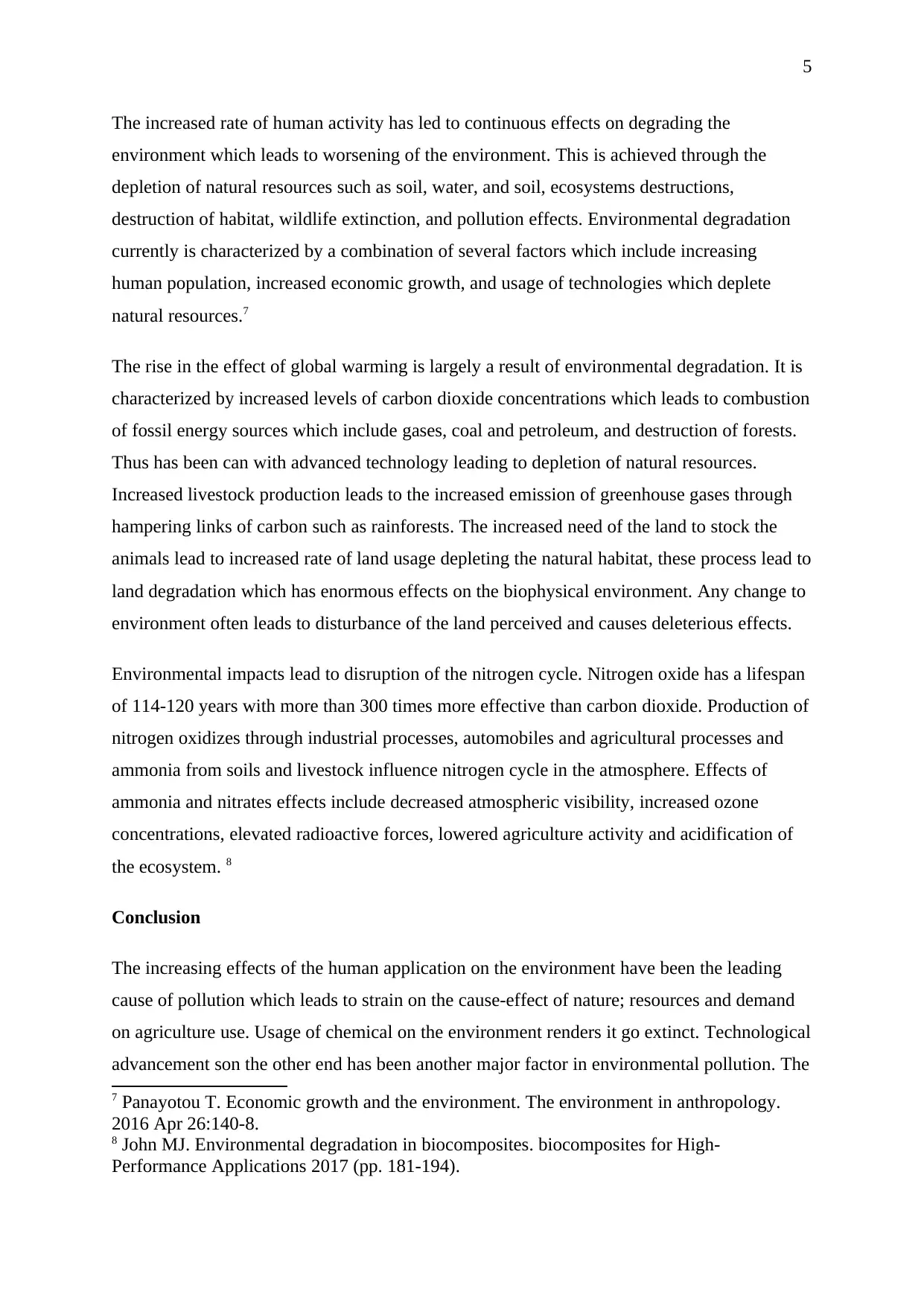
5
The increased rate of human activity has led to continuous effects on degrading the
environment which leads to worsening of the environment. This is achieved through the
depletion of natural resources such as soil, water, and soil, ecosystems destructions,
destruction of habitat, wildlife extinction, and pollution effects. Environmental degradation
currently is characterized by a combination of several factors which include increasing
human population, increased economic growth, and usage of technologies which deplete
natural resources.7
The rise in the effect of global warming is largely a result of environmental degradation. It is
characterized by increased levels of carbon dioxide concentrations which leads to combustion
of fossil energy sources which include gases, coal and petroleum, and destruction of forests.
Thus has been can with advanced technology leading to depletion of natural resources.
Increased livestock production leads to the increased emission of greenhouse gases through
hampering links of carbon such as rainforests. The increased need of the land to stock the
animals lead to increased rate of land usage depleting the natural habitat, these process lead to
land degradation which has enormous effects on the biophysical environment. Any change to
environment often leads to disturbance of the land perceived and causes deleterious effects.
Environmental impacts lead to disruption of the nitrogen cycle. Nitrogen oxide has a lifespan
of 114-120 years with more than 300 times more effective than carbon dioxide. Production of
nitrogen oxidizes through industrial processes, automobiles and agricultural processes and
ammonia from soils and livestock influence nitrogen cycle in the atmosphere. Effects of
ammonia and nitrates effects include decreased atmospheric visibility, increased ozone
concentrations, elevated radioactive forces, lowered agriculture activity and acidification of
the ecosystem. 8
Conclusion
The increasing effects of the human application on the environment have been the leading
cause of pollution which leads to strain on the cause-effect of nature; resources and demand
on agriculture use. Usage of chemical on the environment renders it go extinct. Technological
advancement son the other end has been another major factor in environmental pollution. The
7 Panayotou T. Economic growth and the environment. The environment in anthropology.
2016 Apr 26:140-8.
8 John MJ. Environmental degradation in biocomposites. biocomposites for High-
Performance Applications 2017 (pp. 181-194).
The increased rate of human activity has led to continuous effects on degrading the
environment which leads to worsening of the environment. This is achieved through the
depletion of natural resources such as soil, water, and soil, ecosystems destructions,
destruction of habitat, wildlife extinction, and pollution effects. Environmental degradation
currently is characterized by a combination of several factors which include increasing
human population, increased economic growth, and usage of technologies which deplete
natural resources.7
The rise in the effect of global warming is largely a result of environmental degradation. It is
characterized by increased levels of carbon dioxide concentrations which leads to combustion
of fossil energy sources which include gases, coal and petroleum, and destruction of forests.
Thus has been can with advanced technology leading to depletion of natural resources.
Increased livestock production leads to the increased emission of greenhouse gases through
hampering links of carbon such as rainforests. The increased need of the land to stock the
animals lead to increased rate of land usage depleting the natural habitat, these process lead to
land degradation which has enormous effects on the biophysical environment. Any change to
environment often leads to disturbance of the land perceived and causes deleterious effects.
Environmental impacts lead to disruption of the nitrogen cycle. Nitrogen oxide has a lifespan
of 114-120 years with more than 300 times more effective than carbon dioxide. Production of
nitrogen oxidizes through industrial processes, automobiles and agricultural processes and
ammonia from soils and livestock influence nitrogen cycle in the atmosphere. Effects of
ammonia and nitrates effects include decreased atmospheric visibility, increased ozone
concentrations, elevated radioactive forces, lowered agriculture activity and acidification of
the ecosystem. 8
Conclusion
The increasing effects of the human application on the environment have been the leading
cause of pollution which leads to strain on the cause-effect of nature; resources and demand
on agriculture use. Usage of chemical on the environment renders it go extinct. Technological
advancement son the other end has been another major factor in environmental pollution. The
7 Panayotou T. Economic growth and the environment. The environment in anthropology.
2016 Apr 26:140-8.
8 John MJ. Environmental degradation in biocomposites. biocomposites for High-
Performance Applications 2017 (pp. 181-194).
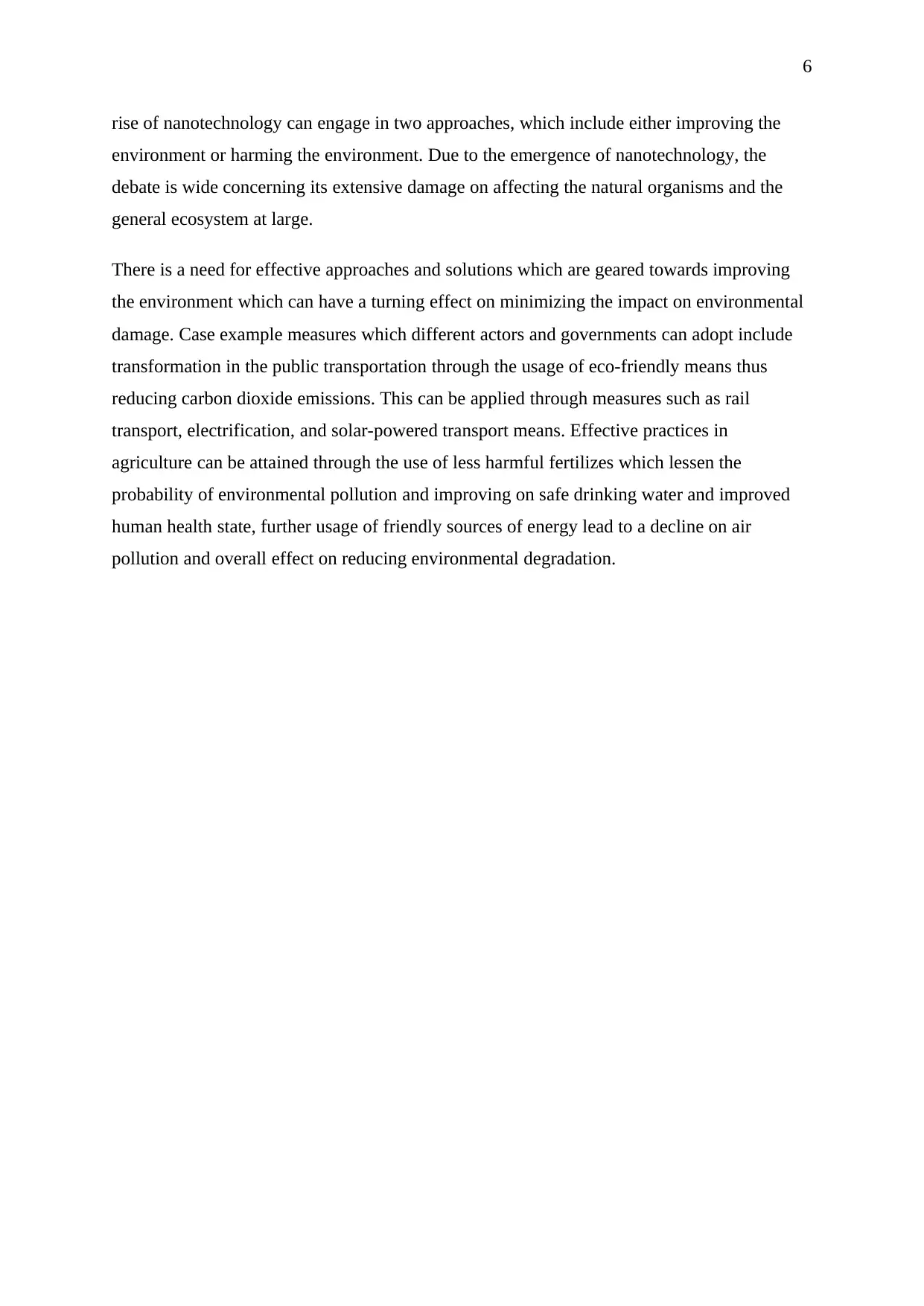
6
rise of nanotechnology can engage in two approaches, which include either improving the
environment or harming the environment. Due to the emergence of nanotechnology, the
debate is wide concerning its extensive damage on affecting the natural organisms and the
general ecosystem at large.
There is a need for effective approaches and solutions which are geared towards improving
the environment which can have a turning effect on minimizing the impact on environmental
damage. Case example measures which different actors and governments can adopt include
transformation in the public transportation through the usage of eco-friendly means thus
reducing carbon dioxide emissions. This can be applied through measures such as rail
transport, electrification, and solar-powered transport means. Effective practices in
agriculture can be attained through the use of less harmful fertilizes which lessen the
probability of environmental pollution and improving on safe drinking water and improved
human health state, further usage of friendly sources of energy lead to a decline on air
pollution and overall effect on reducing environmental degradation.
rise of nanotechnology can engage in two approaches, which include either improving the
environment or harming the environment. Due to the emergence of nanotechnology, the
debate is wide concerning its extensive damage on affecting the natural organisms and the
general ecosystem at large.
There is a need for effective approaches and solutions which are geared towards improving
the environment which can have a turning effect on minimizing the impact on environmental
damage. Case example measures which different actors and governments can adopt include
transformation in the public transportation through the usage of eco-friendly means thus
reducing carbon dioxide emissions. This can be applied through measures such as rail
transport, electrification, and solar-powered transport means. Effective practices in
agriculture can be attained through the use of less harmful fertilizes which lessen the
probability of environmental pollution and improving on safe drinking water and improved
human health state, further usage of friendly sources of energy lead to a decline on air
pollution and overall effect on reducing environmental degradation.
⊘ This is a preview!⊘
Do you want full access?
Subscribe today to unlock all pages.

Trusted by 1+ million students worldwide
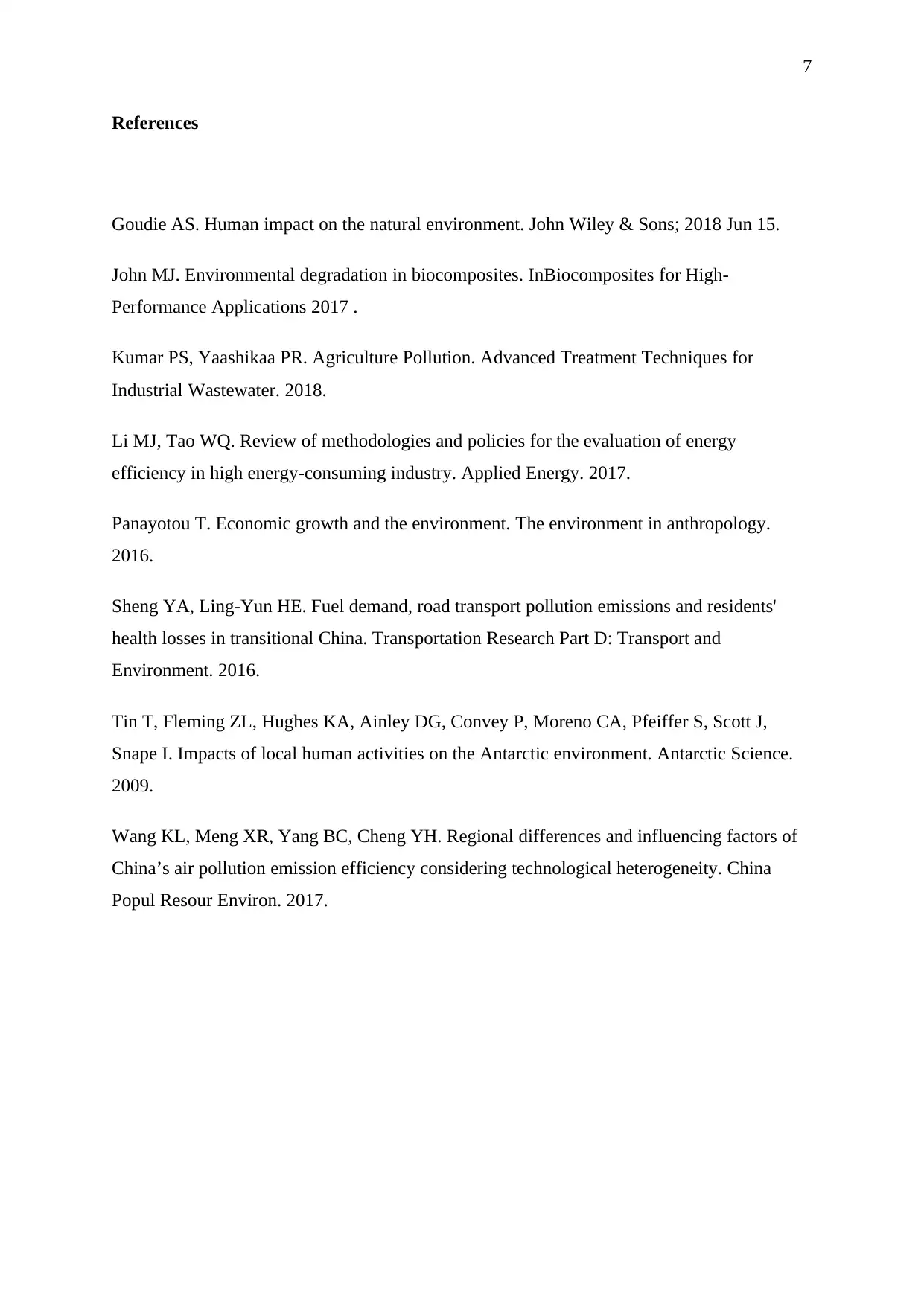
7
References
Goudie AS. Human impact on the natural environment. John Wiley & Sons; 2018 Jun 15.
John MJ. Environmental degradation in biocomposites. InBiocomposites for High-
Performance Applications 2017 .
Kumar PS, Yaashikaa PR. Agriculture Pollution. Advanced Treatment Techniques for
Industrial Wastewater. 2018.
Li MJ, Tao WQ. Review of methodologies and policies for the evaluation of energy
efficiency in high energy-consuming industry. Applied Energy. 2017.
Panayotou T. Economic growth and the environment. The environment in anthropology.
2016.
Sheng YA, Ling-Yun HE. Fuel demand, road transport pollution emissions and residents'
health losses in transitional China. Transportation Research Part D: Transport and
Environment. 2016.
Tin T, Fleming ZL, Hughes KA, Ainley DG, Convey P, Moreno CA, Pfeiffer S, Scott J,
Snape I. Impacts of local human activities on the Antarctic environment. Antarctic Science.
2009.
Wang KL, Meng XR, Yang BC, Cheng YH. Regional differences and influencing factors of
China’s air pollution emission efficiency considering technological heterogeneity. China
Popul Resour Environ. 2017.
References
Goudie AS. Human impact on the natural environment. John Wiley & Sons; 2018 Jun 15.
John MJ. Environmental degradation in biocomposites. InBiocomposites for High-
Performance Applications 2017 .
Kumar PS, Yaashikaa PR. Agriculture Pollution. Advanced Treatment Techniques for
Industrial Wastewater. 2018.
Li MJ, Tao WQ. Review of methodologies and policies for the evaluation of energy
efficiency in high energy-consuming industry. Applied Energy. 2017.
Panayotou T. Economic growth and the environment. The environment in anthropology.
2016.
Sheng YA, Ling-Yun HE. Fuel demand, road transport pollution emissions and residents'
health losses in transitional China. Transportation Research Part D: Transport and
Environment. 2016.
Tin T, Fleming ZL, Hughes KA, Ainley DG, Convey P, Moreno CA, Pfeiffer S, Scott J,
Snape I. Impacts of local human activities on the Antarctic environment. Antarctic Science.
2009.
Wang KL, Meng XR, Yang BC, Cheng YH. Regional differences and influencing factors of
China’s air pollution emission efficiency considering technological heterogeneity. China
Popul Resour Environ. 2017.
1 out of 7
Related Documents
Your All-in-One AI-Powered Toolkit for Academic Success.
+13062052269
info@desklib.com
Available 24*7 on WhatsApp / Email
![[object Object]](/_next/static/media/star-bottom.7253800d.svg)
Unlock your academic potential
Copyright © 2020–2025 A2Z Services. All Rights Reserved. Developed and managed by ZUCOL.





